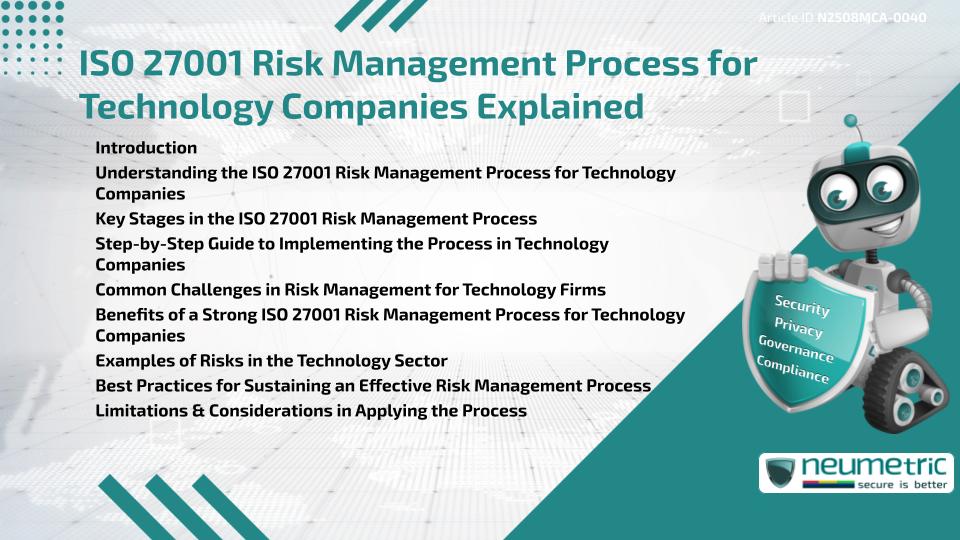Table of Contents
ToggleIntroduction
The ISO 27001 Risk Management process for technology companies is a structured approach to identifying, assessing & treating Information Security Risks. It ensures that technology-driven organisations safeguard data, maintain compliance & meet Client expectations for security. This article explains the stages, practical steps, common challenges, benefits & examples relevant to the technology sector. Whether your organisation is a Software Developer, cloud provider or IT services firm, understanding this process is essential for building a robust Information Security Management System [ISMS].
Understanding the ISO 27001 Risk Management Process for Technology Companies
ISO 27001 is the international Standard for Information Security management. Its Risk Management process is designed to help organisations protect the confidentiality, integrity & availability of their information assets.
For technology companies, this process is particularly critical due to:
- Fast-changing Threat landscapes.
- High reliance on cloud & networked systems.
- Regulatory pressures & Client requirements.
- Large volumes of sensitive Customer & operational data.
At its core, the process involves Risk identification, analysis, evaluation & treatment, followed by monitoring & continual improvement. For a detailed look at ISO 27001 requirements, the ISO.org resource is a valuable starting point.
Key Stages in the ISO 27001 Risk Management Process
- Context Establishment – Understand organisational needs, Stakeholders & legal requirements.
- Risk Identification – Document Threats, Vulnerabilities & affected assets.
- Risk Analysis – Determine Likelihood & potential impact.
- Risk Evaluation – Compare results against acceptable Risk levels.
- Risk Treatment – Select controls to reduce, transfer, accept or avoid the Risk.
- Monitoring & Review – Regularly check the effectiveness of Risk controls.
- Continuous Improvement – Update processes in response to changes or incidents.
You can find more on these stages in the IT Governance ISO 27001 Risk Management guide.
Step-by-Step Guide to Implementing the Process in Technology Companies
- Identify Information Assets – Include applications, databases, hardware, APIs & Intellectual Property.
- Map Threats & Vulnerabilities – Use Threat Intelligence, incident reports & security audits.
- Score Risks – Apply a clear method for assessing Likelihood & Impact.
- Select Controls – Choose measures from Annex A of ISO 27001 or other frameworks such as NIST.
- Assign Risk Owners – Designate responsibility to staff with authority to manage Risks.
- Implement Treatment Plans – Document steps, timelines & resources needed.
- Review & Audit – Use internal audits & management reviews to ensure ongoing compliance.
Common Challenges in Risk Management for Technology Firms
- Dynamic Threats – The rapid pace of change in Cyber Threats can make controls outdated quickly.
- Complex Environments – Multiple systems, platforms & vendors can make consistent Risk Assessment difficult.
- Resource Limitations – Smaller firms may lack dedicated security teams.
- Stakeholder Engagement – Non-technical leaders may undervalue the importance of ongoing Risk Management.
Benefits of a Strong ISO 27001 Risk Management Process for Technology Companies
- Builds Customer Trust through demonstrable security practices.
- Reduces the Likelihood of costly incidents.
- Supports compliance with Data Protection laws.
- Improves operational resilience.
- Provides a Framework for decision-making & prioritisation.
Examples of Risks in the Technology Sector
- Cloud Misconfigurations – Impact: high, Likelihood: medium, Treatment: automated configuration checks & audits.
- Ransomware Attacks – Impact: high, Likelihood: high, Treatment: regular backups, Endpoint Protection, staff training.
- API Exploits – Impact: medium, Likelihood: medium, Treatment: secure coding, API gateways, regular testing.
Best Practices for Sustaining an Effective Risk Management Process
- Conduct quarterly reviews of Risk Assessments.
- Keep asset & Threat inventories up to date.
- Train staff regularly on evolving Risks.
- Integrate Risk Management into change management processes.
- Leverage automation tools for monitoring & reporting.
Limitations & Considerations in Applying the Process
Even with a thorough Risk Management process, no system can eliminate all Risks. The process depends on accurate & timely information & over complication can hinder adoption. Technology companies should focus on practical, clear processes that balance security needs with operational realities.
Takeaways
- The ISO 27001 Risk Management process for technology companies protects data & ensures compliance.
- It involves identifying, assessing, treating & monitoring Risks.
- Effective implementation requires Stakeholder involvement & regular updates.
- Automation & integration with other processes improve effectiveness.
FAQ
What makes the ISO 27001 Risk Management process crucial for technology companies?
It addresses the high-Risk nature of digital environments & protects sensitive assets.
How often should Risk Assessments be conducted in a technology company?
At least quarterly or after significant changes to systems or operations.
Can small technology companies implement this process effectively?
Yes, by tailoring the process to available resources & focusing on high-priority Risks.
Does the process only apply to cyber Risks?
No, it also covers physical, operational & compliance-related Risks.
Is automation necessary for ISO 27001 Risk Management?
Not mandatory, but automation improves efficiency & consistency.
Who should be responsible for managing Risks in a technology company?
Typically, the ISMS manager, supported by IT & business leaders.
Can the process be integrated with other frameworks?
Yes, it aligns well with NIST, COBIT & other recognised frameworks.
Need help for Security, Privacy, Governance & VAPT?
Neumetric provides organisations the necessary help to achieve their Cybersecurity, Compliance, Governance, Privacy, Certifications & Pentesting needs.
Organisations & Businesses, specifically those which provide SaaS & AI Solutions in the Fintech, BFSI & other regulated sectors, usually need a Cybersecurity Partner for meeting & maintaining the ongoing Security & Privacy needs & requirements of their Enterprise Clients & Privacy conscious Customers.
SOC 2, ISO 27001, ISO 42001, NIST, HIPAA, HECVAT, EU GDPR are some of the Frameworks that are served by Fusion – a SaaS, multimodular, multitenant, centralised, automated, Cybersecurity & Compliance Management system.
Neumetric also provides Expert Services for technical security which covers VAPT for Web Applications, APIs, iOS & Android Mobile Apps, Security Testing for AWS & other Cloud Environments & Cloud Infrastructure & other similar scopes. Reach out to us by Email or filling out the Contact Form…


